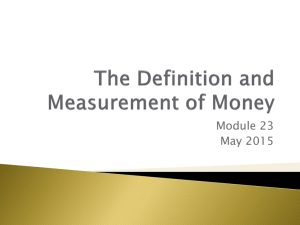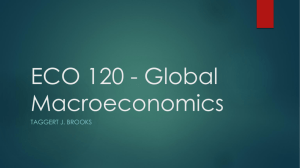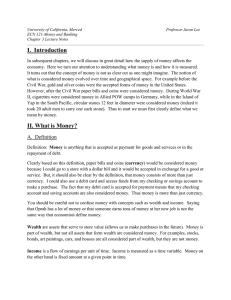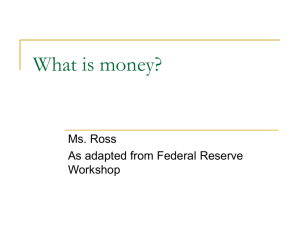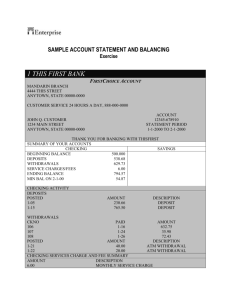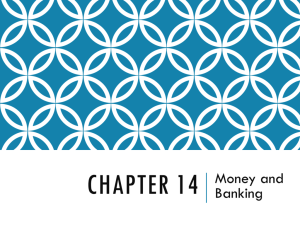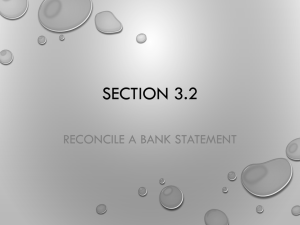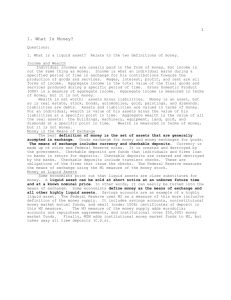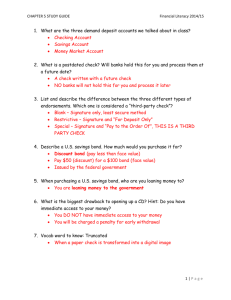Chapter 14- Money and Banking
advertisement
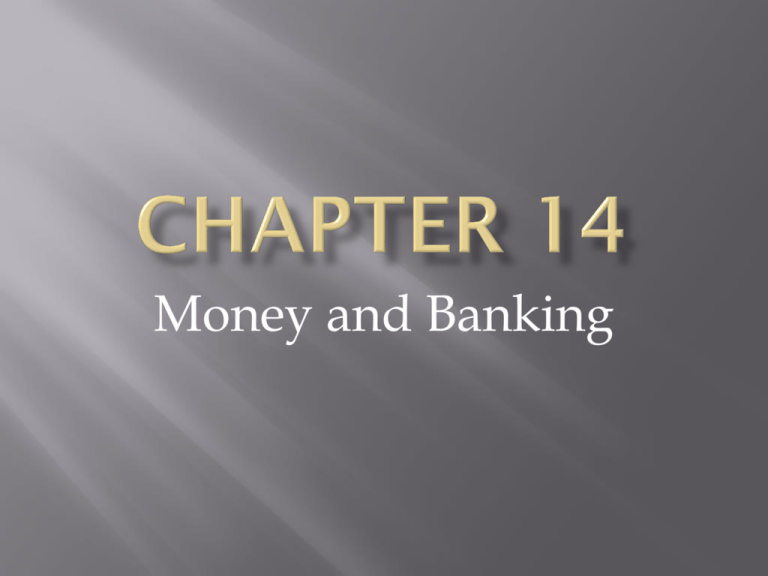
Money and Banking The Functions and Characteristics of Money Medium of Exchange Something a seller will accept in exchange for a product or service. Without money, people would have to barter, a much more complicated process involving a double coincidence of wants. Unit of Accounting It is used to measure and compare the values of different items and services. Helps to keep accurate financial records Store of Value It is used as a store of value—sell one thing (such as labor) and save its value (paycheck) for use at a later time. Any item that wants to be money must meet six criteria: Durable—withstands wear and tear of being passed around Portable—must be easy to transport Divisible—must be able to divide it into small parts in order to purchase things of differing value Must have stable value Must be a scarce item so that there is not too much of it. Must be accepted by the sellers and buyers in community Commodity Money: a medium of exchange such as cattle or gems that has value as a commodity or good aside from its value as money Cattle are used for food; gems are used for jewelry. Representative Money: money that is backed by an item of value such as by gold or silver The amount of money in circulation would be limited because it is linked to some scarce good, such as gold. Fiat Money: money that has value because a government fiat, or order, has established it as acceptable for payment of debts Today, all US money is fiat money and is declared legal tender. Legal Tender: money that by law must be accepted for payment of public and private debts History of American Money and Banking England forbade Colonial America from using printed money or minted coins. Bartering of various goods was used in place of money. When the war came, the Continental Congress issued bills of credit (Continentals) to pay war debts. Too many Continentals were issued and they became worthless. After the war, the United States began to mint its own coins backed by gold and silver. Checking accounts Automatic deposit and payment Storage of valuables Money transfers Overdraft checking, which allows a customer to write a check for money that is in the account and the bank will loan the money to be paid back at a high interest rate. Computers ushered in a new form of banking—electronic fund transfers (EFT) Automated teller machines (ATMs) Lack of privacy and possibility of tampering are risks of electronic bank transfers. Customer has little “float” time between writing the check and its being cashed by the bank. Electronic Funds Transfer Act helped calm some of these concerns. Types of Money in the United States Currency Coins and bills (notes) Federal Reserve Notes and United States Notes are legal tender. Credit Cards and Debit Cards Credit cards are not really money; they are representative of future claims to funds. Credit cards actually defer the completion of the transaction to a later date. Debit cards are similar to checks, but the withdrawal is done electronically. Checks Checks and checking accounts offer checkable deposits. Today all thrift institutions offer checkable deposits. Checking Account: account in which deposited money can be withdrawn at any time by writing a check Checkable Deposits: money deposited in a bank that can be withdrawn at any time by presenting a check. Thrift Institutions: mutual savings banks, S&Ls, and credit unions that offer many of the same services as commercial banks Near Moneys Near Moneys: assets, such as savings accounts, that can be turned into money relatively easily and without the risk of loss of value Near moneys are assets that have values stated in terms of money, but are not themselves money. Near money can easily be turned into money, such as savings accounts or time deposits. Definition M1 includes: all currency, all deposits in checking accounts, and travelers’ checks. Definition M2 includes: all of M1 plus savings deposits, Time deposits, small denomination CD’s, money market deposit accounts, money market mutual fund balances, And other specialized account balances.
